prev knowledge
- deployment techniques
- 量化quantization
- 剪枝pruning
- 蒸馏distillation
- QAT & PTQ
- QAT:Quantization-Aware Training,通过训练的方式达到与浮点模型精度一致的量化模型,需要重训练
- PTQ:post-training quantization,训练感知量化,通过对量化层determine the value range来降低量化误差
- without finetuning:直接用calibration后的quant weight做floor/ceil round
- finetuning:如Adaround,calibration后的quant weight自适应地学+1/+0
- LayerNorm
PTQ
given原始输入$x$
quantization
- 对称量化:$x_q = clip(round(\frac{x}{s}), -2^{b-1}, 2^{b-1}-1)$
- 非对称量化:$x_q = clip(round(\frac{x}{s})+zp, -2^{b-1}, 2^{b-1}-1)$
dequantization
- $\hat x=x_q*s$
- $\hat x=(x_q-zp)*s$
- 理想的$\hat x$应该约等于$x$
matmul
- $\hat Y = (x_q w_q)s_xs_w$
- $\hat Y = (x_q-zp_x)s_x(w_q-zp_w)*s_w=s_xs_w(x_qw_q +zp_xzp_w - zp_wx_q-zp_xw_q) $
- 其中带$x_q$的两项是dynamic的
- 比对称量化多引入一个矩阵乘
CUDA progamming
GPU作为CPU的外挂设备,CPU作为host
- 准备数据,image.cuda()
- luanch kernel,gpu进行实际的op计算
- 结果返回,reuslt.cpu()
memory structure
- 金字塔结构
- register:thread-private的mem
- local memory:为了防止register溢出的bkp
- shared memory:among a block
- global memory:显存
Cuda Core
- 标准的浮点计算单元,one operation per cycle
- progress in parallel
Tensor Core
- 用于优化特定op,如4x4GEMM
- 如果float16改成int8,单个cycle的计算能力就翻倍了
Fake Quant
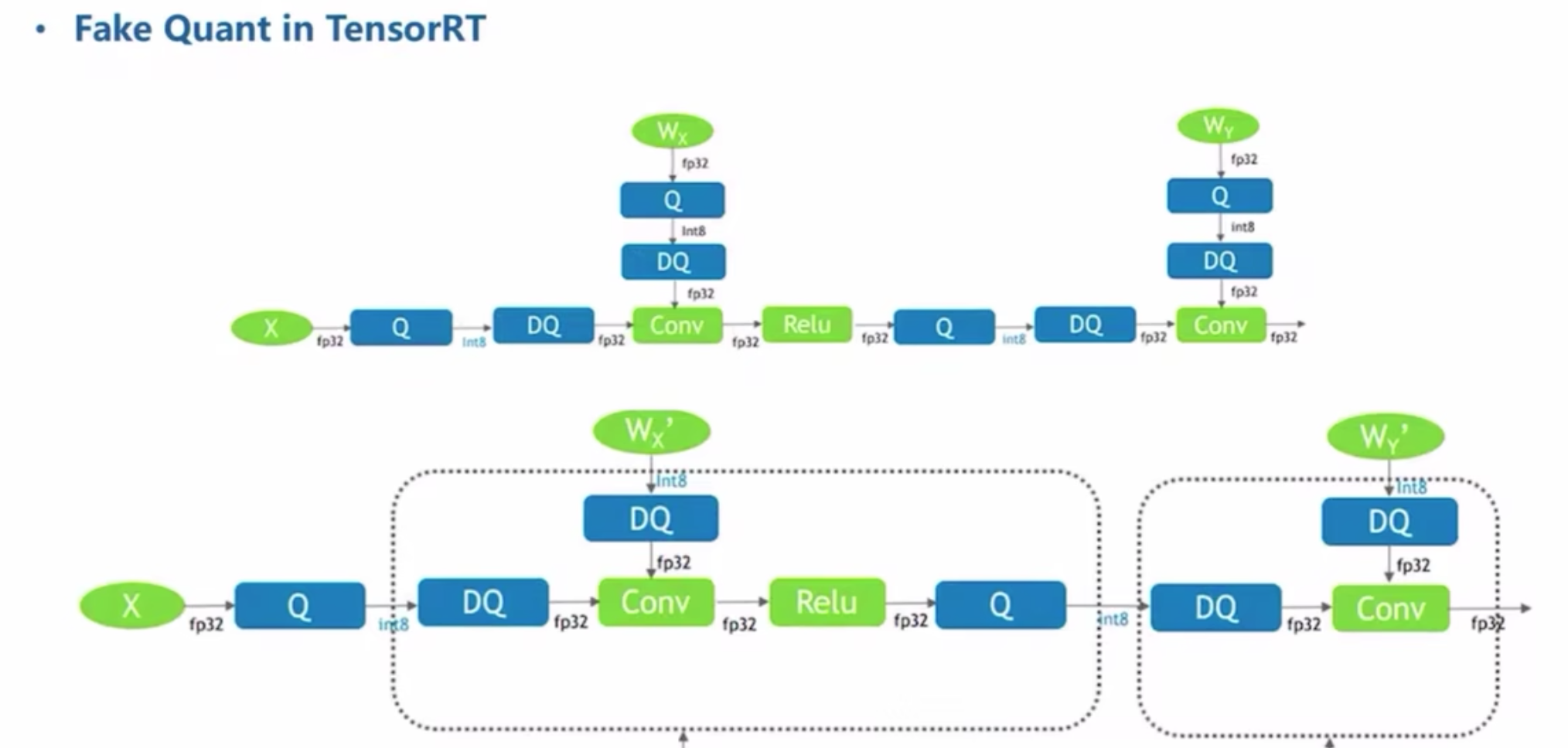
- 通常X的Q是per tensor的,W的Q是per channel的
- W的Q可以离线计算好
- DQ+float conv-relu的部分可以融合为QConvRelu,输入/输出都是int8,可以放到Tensor Core去算实现加速
FP16 & Int8
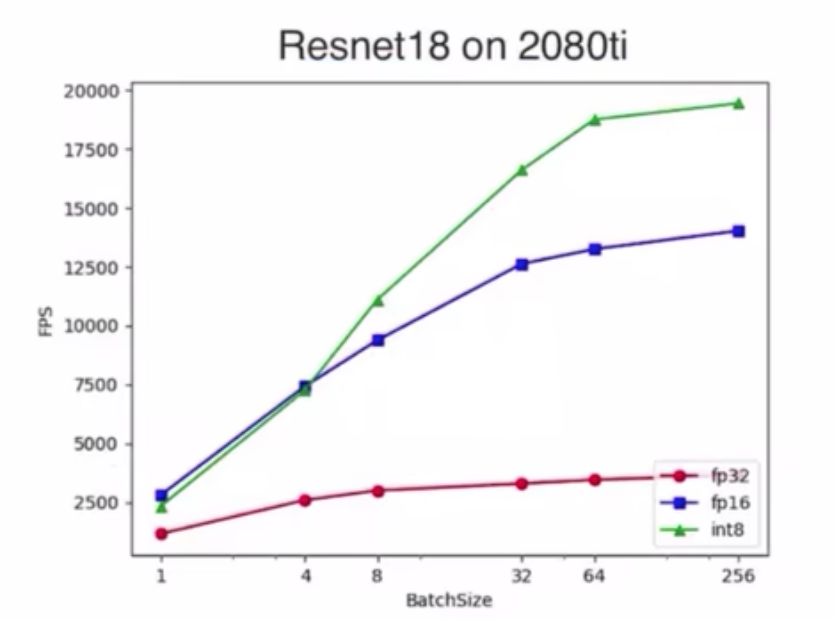
- bs比较小的时候,还没到数据搬运瓶颈
- bs大的时候,int8才显著
ViT
PTQ method1
- 量化矩阵乘:QK,attnV,mlp
- 计算similarity loss:皮尔逊相关系数,$sim(Y, \hat Y)$
- 计算ranking loss:监督attn的相对关系
- 交替循环采样
- 首先计算X和W的calibration
- fix X的calibration,采样W的calibration,得到最好的$s_w$
- fix W的calibration,采样X的calibration,得到最好的$s_x$
- 交替
PTQ method2
LN
- BN vs. LN:BN保存per-channel的statics,LN动态计算per-tensor的statics,不能融合进conv,需要独立量化
- LN的输入数值范围分布比较大,要么损失离群点,要么拉大range损失small value的quant precision
如果用per-channel量化来解,在DQ的时候恢复的数值范围不一致,还是要用浮点防止溢出
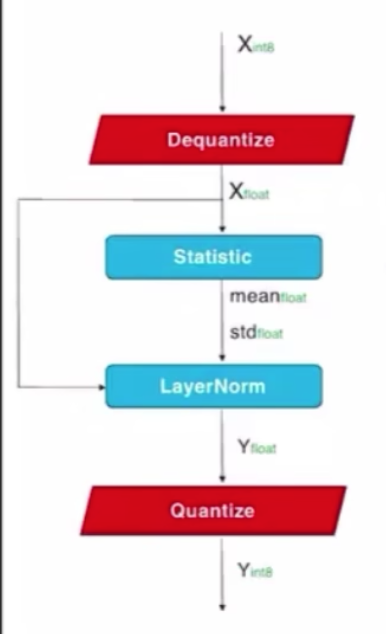
把channel scale表征成2的幂数,在rescale的时候可以替换成移位操作
Softmax
log2放大small value的quant range
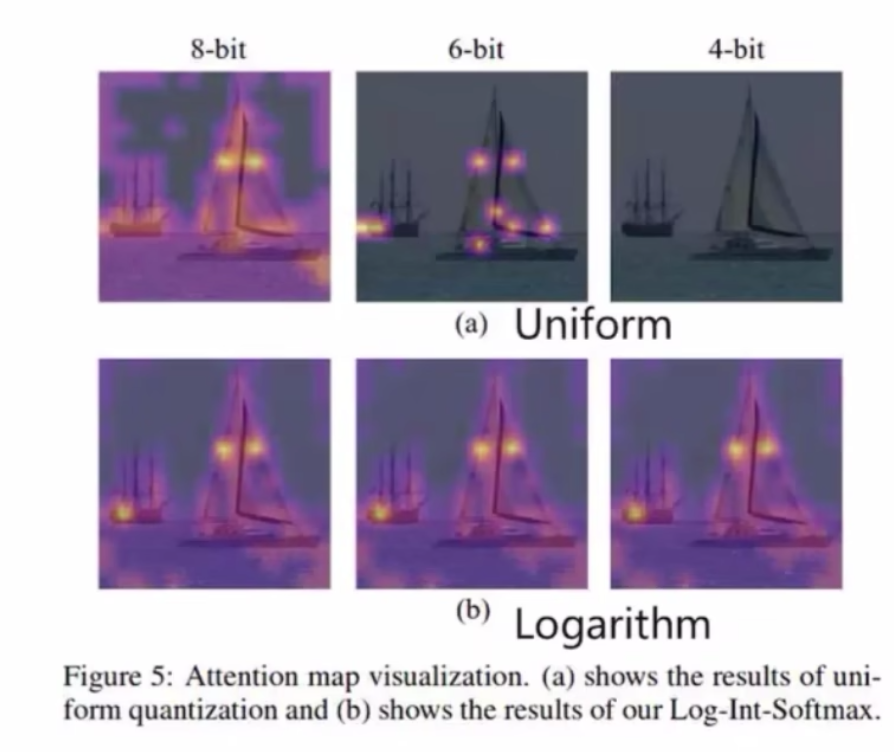
i-exp将softmax转换成整数运算,因此可以直接输入前面的量化结果$softmax(s*x_q)$
- log2量化以后的DQ可以看成
- $x_q=-log2(x)$
- $\hat x=2^{-x_q}$,做attnV的matmul的时候可以直接移位
pipeline
model to Qmodel:trace静态图节点
- qconfig配置
build qmodel
1
2
3
4
5
6
7
8
9
10
11
12
13from sparsebit.quantization import QuantModel, parse_qconfig
from model import resnet18
model = resnet18(num_classes=10)
model.load_state_dict(torch.load('pretrained.pth'))
# eval float model
# ...
# build quant model
qconfig_file = "qconfig.yaml" # W8A8
qconfig = parse_qconfig(qconfig_file)
qmodel = QuantModel(model, config=qconfig)
calibration:计算qparams
PTQ
1
2
3
4
5
6
7
8
9
10
11
12
13
14
15# Set calibration
qmodel.prepare_calibration()
# Forward Calibrate
calibration_size = 256
cur_size = 0
if torch.cuda.is_available():
qmodel.cuda()
for data,target in trainloader:
if torch.cuda.is_available():
data,target = data.cuda(),target.cuda()
res = qmodel(data)
cur_size += data.shape[0]
if cur_size >= calibration_size:
break
qmodel.calc_qparams()QAT训练
1
2
3
4
5
6qmodel.init_QAT() #调用API,初始化QAT
qmodel.set_lastmodule_wbit(bit=8) #额外规定最后一层权重的量化bit数
print(qmodel.model) #可以在print出的模型信息中看到网络各层weight和activation的量化scale和zeropoint
# train like a float model, fake quantize等过程在QuantModel中自行完成
# Q/DQ nodes simulate quantization loss and add it to the training loss during fine-tuning
* 得到quant model,导出onnx
1
2
3
4
5
6
7
8
9
10
11
12
13
14
15
16
17
18
19
# Set Quantization
qmodel.set_quant(w_quant=True,a_quant=True)
correct = 0
total = 0
qmodel.eval()
with torch.no_grad():
for data in testloader:
image,labels = data
if torch.cuda.is_available():
image,labels= image.cuda(),labels.cuda()
outputs = qmodel(image)
_,predicted = torch.max(outputs.data,1)
total+=labels.size(0)
correct += (predicted == labels).sum().item()
acc1 = 100 * correct / total
print(f'Accuracy of the Quant Model on the 10000 test images: {acc1} %')
# 导出onnx
qmodel.export_onnx(torch.randn(1, 3, 224, 224), name="qresnet20.onnx")
9. homework
* imagenet上resnet18、vgg16、mobileNetv2的PTQ掉点情况
* Resnet18<vgg16<mobileNetv2
* mobilenetv2量化之后掉点严重的主要原因在于该网络中的深度可分离卷积,Depthwise Conv不同输出通道的动态范围差异较大,因此采用per-tensor的量化方式将会引入较大的量化误差,从而导致精度损失严重,采用per-channel的量化能够缓解精度损失的问题。
* 把calibration-set里面的图片换成标准高斯噪声输入, 当calibration-set大小为1, 10, 100时, 精度不是0或者很低的原因是什么呢
* 图像预处理的Normalization操作可确保数据满足N(0,1)的高斯分布,与随机高斯噪声类似
* moving average calibration with alpha from [0.5, 0.9, 0.99]
* 全局的calibration MinMax好过moving average MinMax,因为step有限的情况下两者并不接近
* alpha越大结果越差
* int8和float16的模型latency比较
* 二者在GPU中的速度并没有太大区别,int8的主要优势在于传输数据,相同带宽下,Int8传输的数据量是FP16的两倍
* BatchSize较小时,其传输带宽并没有被完全利用,GPU上Int8和FP16的Throughput接近
* QAT resnet18 with 4w4f & 2w4f
FQ-ViT: Post-Training Quantization for Fully Quantized Vision Transformer
introduction
- difficuties in quant ViT
- serious inter-channel variation in LayerNorm inputs:一些通道的值是均值的40倍,这种fluctuation一般的量化方法解决不了,会导致large quantization error
- extreme non-uniform distribution in attention maps:attn map中大多数的units范围在0-0.01,只有少数high attention接近1,极小值在量化过程中的精度损失比较大
- propose Fully Quantized Vision Transformer (FQ-ViT)
- PTF:power of Two Factor,能够降低LN的量化误差,计算量与layer-wise quantization一致
- LIS:log int softmax,能够 provides higher quantization resolution for small values
- simplify 4- bit quantization by the BitShift operator
- difficuties in quant ViT
method
quantization preliminary
- 量化$Q(X|b)$就是将浮点值域$X\in R$映射到量化值域$b\in q$
- b代表bit width,那么量化值域q的分布为
- signed:$\{-2^{b-1}, …, 2^{b-1}-1\}$
- unsigned:$\{0,1,2,…, 2^b-1\}$
- quantizer Q最常用的是uniform和log2
- Uniform Quantization
- $Q(X|b) = clip(\frac{X}{s}+zp,0,2^b-1)$
- 两个量化参数通常是由X的分布决定,given lower bound $l$ & upper bound $u$
- scale $s=\frac{u-l}{2^b-1}$
- zero-point $zp=clip(-\frac{l}{s}, 0, 2^b-1)$
- Log2 Quantization
- 非线性映射
- $Q(X|b) = sign(X)\cdot clip(-log_2\frac{|X|}{max(|X|)}, 0, 2^b-1)$
- 会放大small value的量化区域:如果X值很大如[0.5,1],那么对应log2的范围在[0,1],如果X值很小如[0,0.5]那么log2的范围就在[1,inf],可以看到log2可以放大小值的量化范围,但是对极小值有精度损失
- Uniform Quantization
- this paper fully quantize ViT
- uniform MinMax quantization is used for Conv, Linear and MatMul
- following new proposed methods are used for LayerNorm and Softmax
Power-of-Two Factor for LayerNorm Quantization
LayerNorm:$LN(x)=\frac{X-\mu_X}{\sqrt{\sigma_X^2 + \epsilon}} \cdot \gamma + \beta$
dynamic computing of mean & variance $\mu_X$ and $\sigma_X$
reaffine by trained $\gamma$ and $\beta$
LN层要动态norm,所以不能跟前面的线性层合并
look into LN的inputs:there is a serious inter-channel variation,整体的输入值分布范围很大,而且channel之间的最大值最小值差异很大

inter-channel的extreme variation导致layer-wise quantization有很大的quant error
- group-wise quant和channel-wise quant:会引入更多的mean和var的计算
- Power-of-Two Factor (PTF):only introduce a channel-wise factor
$X_Q = Q(X|b) = clip(\frac{X}{2^\alpha s}+zp, 0, 2^b-1)$
- $s=\frac{max(X)-min(X)}{2^b-1} / 2^K$
- $zp=clip(-\frac{min(X)}{2^K s},0,2^b-1)$
- 新引入的per-channel factor $\alpha_c= argmin ||X_c - \frac{X_c}{2^{\alpha_c} s} \cdot 2^{\alpha_c} s||_2$ among $\alpha_c\ in \ [0,1,2,…, K]$
- hyperparam K:default K=3,可以根据需求调整,控制的是scaling factor的范围,决定了保留的精度区间,如果$X_c$的variation很大,那么对应的$\alpha_c$也要大一些
$X_Q$是LN的输入前量化,所以我们还可以基于它计算integer domain的LN的mean & var
- 首先还原网络输入:$\hat X_Q = (X_Q - zp) << \alpha$
- 网络的输入:$X = s * \hat X_Q$
- $\mu (X) = \mu (s \hat X_Q) = \mu(\hat X_Q) s$
- $\sigma (X) = \sigma (s \hat X_Q) = \sigma (\hat X_Q) s$
- 这样就可以在integer domain得到LN的量化前输出:$Y=\gamma * s \frac{\hat X_Q - \mu(\hat X_Q)}{\sqrt {s^2 \sigma^2(\hat X_Q)} + \epsilon} + \beta$
量化LN层
- given quant param $s_{out}$ & $zp_{out}$
- $Y_Q = \frac{Y}{s_{out}} + zp_{out} = \frac{\gamma s }{s_{out} \sqrt {s^2 \sigma^2(\hat X_Q)+\epsilon}} \hat X_Q + \frac{\beta\sqrt {s^2 \sigma^2(\hat X_Q)+\epsilon} - \gammas\mu(\hat X_Q)}{s_{out } * \sqrt {s^2 \sigma^2(\hat X_Q)+\epsilon}} + zp_{out} = A \hat X_Q + B + zp_{out}$
- A近似为
- given 目标位宽b
- $N_1=b-1-log_2|A|$
- $N_2= |A| 2^{N_1}$
- $A=sign(A) \cdot \frac{N_2}{2^{N_1}}$
- 最终的量化推理:$Y_Q=\frac{sign(A) \cdot {N_2} \hat X_Q + B*2^{N_1}}{2^{N_1}} + zp_{out}$
Log-Int-Softmax for Softmax Quantization
look into attn map:a distribution centering at a fairly small value,然后少数离群点在1附近
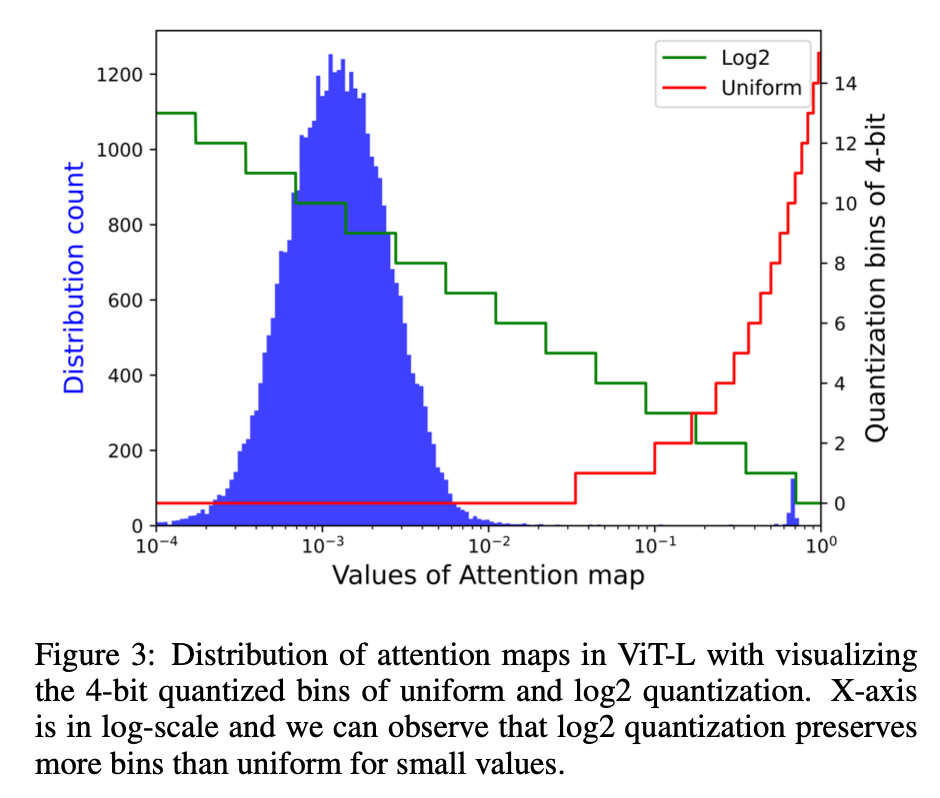
log2 quant
- 首先softmax自带normalization
- 其次后面的attn*VQ这个matmul算子也可以通过bitshift来实现
$Attn_Q = Q(Attn|b) = clip(-log_2{Attn}, 0, 2^b-1)$
after quant matmul
- $Attn V_Q = 2^{-Attn_Q} V_Q = V_Q >> Attn_Q$
- 右移会损失精度,所以改成左移,$V_Q>>Attn_Q = V_Q << (N-Attn_Q) / 2^N$,$N=2^b-1$
softmax计算的优化LIS Log-Int-Softmax
- 使用i-exp来polynomial approximation of exponential function
- $exp(s X_Q) = s^{‘}i-exp(X_Q)$
- Log-Int-Softmax:$LIS(s*X_Q) = N- log_2 \frac{\sum i-exp(X_Q)}{i-exp(X_Q)}$
- integer的log2就是找bit码中第一个1,然后累加后面的值
- i-exp就是近似表达式
- softmax(X)先转化:$\hat X=X-max(X)$,输入变为负数
- exp(X)分解:$exp(\hat X) = 2^{-z}exp(p) = exp(p)>>z$
- $z=\frac{-\hat X}{ln2}$
- $p = \hat X + zln2 \in (ln2, 0]$
- exp(p)近似:$L(p) = 0.3585(p+1.353)^2 + 0.344 \approx exp(p)$
- $exp(\hat X) \approx L(p)>>z$
- 归一化$exp(\hat X)$得到integer softmax
- attn的量化用了int4来节省计算量
对比
- 不量化softmax需要QK之后先dequant,移动到cpu进行浮点计算,然后再quant,再移动回GPU/NPU
proposed method始终在GPU里,始终是integer
